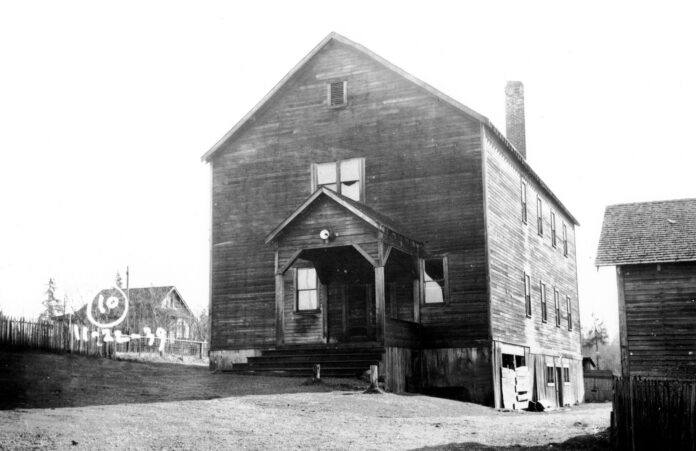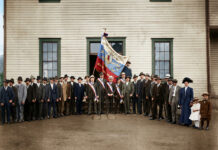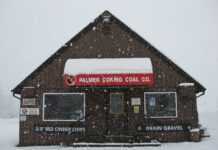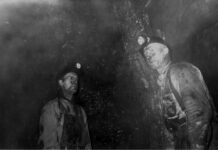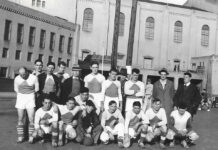As a working-class town, Labor Day has long been Black Diamond’s biggest celebration. It’s the day they close Highway 169 for a few hours to stage a parade on what Black Diamond calls Third Avenue. It’s two streets east of Railroad Avenue, where locomotives once pulled scores of loaded coal cars to Seattle’s waterfront, where they were loaded for shipment up and down the West Coast.
Black Diamond’s first coal mine, Mine #14, shipped its first train load of coal in December 1884. By May 1885, a one-week strike organized by the Knights of Labor won Black Diamond’s miners a pay increase. And for most of the first 90 years, when coal was being mined and shipped from Black Diamond, labor unions have played an important role in speaking on the coal miners’ behalf.
The Knights of Labor was America’s largest labor union in the 19th century, claiming nearly one million members. By the mid-1880s, over 20% of all workers were affiliated with the Knights. However, after the Haymarket Riot of 1886, the organization collapsed, and nearly 90% of its members left.
Four years later, on Jan. 25, 1890, a new union was born to lead Black Diamond’s coal miners to the promised land – the United Mine Workers of America, or UMWA. Eight years after its founding, on April 1, 1898, the UMWA achieved the eight-hour day for its members. The 25th anniversary of UMWA’s founding was celebrated in the Morganville Union Hall, pictured above.
The Morganville Union Hall was located at 32522 Buena Vista Drive, on Block 6, Lot 18. It was built in 1922, measuring 36 feet by 70 feet deep, with two stories. It rested on a full basement foundation with an eight-foot ceiling height. The Union Hall burned to the ground in May 1945, according to a report Abramo Pennacchi (1881-1958) filed with the Assessor on July 12, 1945.
This King County Assessor photo of tax lot 564260-0275, taken Nov. 22, 1939, comes courtesy of JoAnne Matsumura, an Issaquah historian. At the time of the photo, the property deed was held by H.J. Allsopp, as trustee of the United Mine Workers District 10. Photo enhancements were provided by Doug “Boomer” Burnham, who teaches photography skills at Tahoma High School.
In Black Diamond, efforts to organize under the United Mine Workers umbrella were generally unsuccessful until 1907. After the Union began meeting at the railroad depot, now the Black Diamond History Museum, Pacific Coast Coal (PCC) officials, who operated as a company town, prohibited further assemblies there. As a result, workers gathered half a mile west, 75 feet across the section line, and beyond company property. Workers assembled at a large Douglas fir tree stump where speeches were given. The Union Stump is now encased in concrete, located in a quarter-acre triangular park due north of the Black Diamond Cemetery.
Shortly thereafter, Local 2257 of the UMWA was organized. And without a strike, the Union obtained the eight-hour day and wage increases for Black Diamond’s miners. For the next 12 years, labor peace generally held. Wages rose, fueled by higher coal prices, as production boomed. The WW-I years were particularly fruitful in Washington State as coal output set the all-time record of over four million tons.
With peace in Europe in 1918, came a fall in production and lower coal prices. Workers agitated for higher wages, but in 1921, the union miners were locked out by Pacific Coast and replaced by strikebreakers. A bitter labor dispute followed, and union miners were forced from company houses located in the PCC-controlled townsite.
An old coal miner named Tim Morgan, who owned the Union Stump property, again came to the assistance of the miners by donating a large section of his property to the union. Over the next year, nearly 200 homes were built by locked-out coal miners in an assembly line fashion on Morgan’s property. That part of town has been called Morganville ever since. Tim Morgan is buried in the nearby Black Diamond cemetery.
The labor dispute ended in 1922, and most of the union miners got their jobs back. But King Coal’s days were over – five years later, Black Diamond’s largest and most successful Mine No. 11 closed. The New Black Diamond Mine opened between Maple Valley and Renton, and many of the town’s miners began working there. But over time, the coal mines closed and workers found employment by commuting to jobs with growing companies like Pacific Car & Foundry and Boeing. Underground coal mining came to an end in 1975, when the nearby Rogers No. 3 mine closed, though surface mining continued locally for another 25 years.
This weekend, Black Diamond celebrates Labor Day with the annual parade at 10 am on Monday, plus a host of events including Doggy Day, Citizen Awards, games, and a free movie on Sunday. For more information, go to the Black Diamond Labor Days’ Facebook page or check out their website: www.BlackDiamondLaborDays.org

